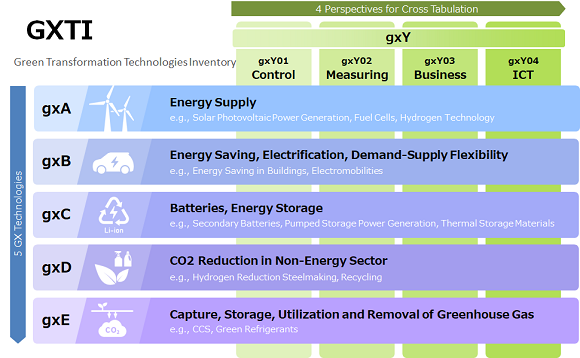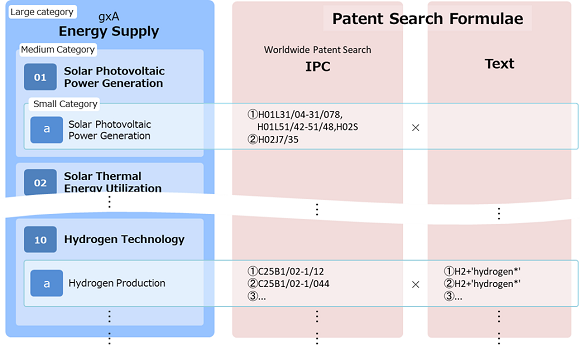Home> Statistics/References> Statistics> Overview of the GXTI
Main content starts here.
Overview of the GXTI
Three features of the GXTI
The GXTI has the following three features:

The first feature is that the GXTI illustrates how to categorize GX technologies.
The GXTI consists of three levels of hierarchy as follows:
Large categories (comprises 6 large categories)
Medium categories (comprises 32 medium categories)
Small categories (comprises 86 small categories)
The symbol for each category starts with “gx”.

Large Category
The large category consists of five perspectives: (1) energy supply(gxA), (2) energy demand(gxB), (3) energy storage(gxC), (4) CO2 reduction in non-energy sectors(gxD) and (5) capture, storage, utilization and removal of greenhouse gas(gxE).
A separate set of four transversal perspectives(gxY) is also provided in the large category. The four perspectives are “control-related technology”, “measurement-related technology”, “business-related technology” and “ICT-related technology”. GxY is the cross tabulation of these four perspectives and five GX technology categories, gxA to gxE. In other words, the number of patent documents in gxY is an inner number of the number of patent documents in gxA-gxE. GxY can be used to identify trends in GX technologies which include each of the transversal perspectives. ("Energy Supply X Control and Coordination", for example)
Medium Category and Small Category
In the medium category and the small category, important individual technologies in each large category are listed.
In the GXTI, the small category illustrates what specific technologies are involved in the medium category, and analyses of patent application trends are expected to be conducted by the unit in the medium category. It is also possible, of course, to make analyses by the units in the small category.
In some cases, a patent document might involve multiple technologies listed in the medium category and/or the small category. Since the small category was created with the principal aim of linking each category with a patent search formula, the technical granularity differs by the category. Some small categories in the same small category are conceptually overlapped.
The second feature is that the patent formulae are published, meaning that anyone can search patent documents in the same way, and can obtain the same objective results using the published patent formulae that correspond to each small category.
As above, the GXTI consists of three hierarchical structures of categories (large, medium, and small categories), and the patent formulae corresponding to each small category. It is possible to search for patents corresponding to each category of technology in the small category and the number of the patents.
In case of searching for all relevant patents in the medium category, large category or the whole GXTI, all the patent formulae in the small category under that category must be added up (By taking the union set).

The third feature comprises patent formulae that do not use specific search indexes from a limited number of countries and regions, but use International Patent Classifications (IPC) or a combination of IPCs and keywords.
※At this point in time, IPC is used for over 100 countries and regions, including members of the Strasbourg Agreement.

GXTI (GX Technologies Inventory)
- GXTI (GX Technologies Inventory) Creation (with links easily searchable in J-PlatPat) [Updated: March 18, 2025].
- GXTI (GX Technologies Inventory in English) (incl. Patent Search Formula, Excel version) (Excel:57KB) [Last updated: 31 October 2023]
- GXTI (GX Technologies Inventory in English) (Technologies Inventory Only, PDF version) (PDF:251KB)
The GXTI provides patent search formulae specific to searches via Logical Expression Input on J-PlatPat (External link), which is a free patent search database provided by INPIT.
The patent search formulae are not only valid for J-PlatPat but also in other patent search databases. For GXTI modifications, please refer to the sheet titled “contents of modification” in the Excel file that you can download from the above.
In the table below, it is possible to open a page with a search formula entered on the J-PlatPat search screen from a link for each technology category and to easily perform a search by technology category.
| GXTI | Search on J-PlatPat | ||||||
|---|---|---|---|---|---|---|---|
| Level 1 | Level 2 | Level 3 | |||||
| gxA | Energy Supply | ||||||
| 01 | Solar Photovoltaic Power Generation | ||||||
| a | Solar Photovoltaic Power Generation | gxA01a(External Link) | |||||
| 02 | Solar Thermal Energy Utilization | ||||||
| a | Solar Thermal Power Generation | gxA02a(External Link) | |||||
| b | Solar Thermal Collectors, Solar Thermal Systems | gxA02b(External Link) | |||||
| 03 | Wind Power Generation | ||||||
| a | Wind Power Generation | gxA03a(External Link) | |||||
| 04 | Geothermal Utilization | ||||||
| a | Geothermal Power Generation | gxA04a(External Link) | |||||
| b | Geothermal Collectors, Geothermal Systems | gxA04b(External Link) | |||||
| 05 | Hydro-Power Generation | ||||||
| a | Hydro-Power Generation | gxA05a(External Link) | |||||
| 06 | Ocean Energy Power Generation | ||||||
| a | Wave Power Generation, Tidal Power Generation | gxA06a(External Link) | |||||
| b | Ocean Thermal Energy Conversion, Ocean Salinity Gradient Power Generation | gxA06b(External Link) | |||||
| 07 | Biomass | ||||||
| a | Solid Biofuels | gxA07a(External Link) | |||||
| b | Liquid Biofuels | gxA07b(External Link) | |||||
| c | Biogas | gxA07c(External Link) | |||||
| 08 | Nuclear Power Generation | ||||||
| a | Fusion Reactors, Nuclear Reactors, Nuclear Power Plant | gxA08a(External Link) | |||||
| 09 | Fuel Cells | ||||||
| a | Fuel Cells, Fuel Cell Systems (Stationary, Mobility) | gxA09a(External Link) | |||||
| 10 | Hydrogen Technology | ||||||
| a | Hydrogen Production | gxA10a(External Link) | |||||
| b | Hydrogen Storage, Transportation, Supply, Hydrogen Stations | gxA10b(External Link) | |||||
| c | Use of Hydrogen in Combustion (Hydrogen Engine Vehicles, etc.) | gxA10c(External Link) | |||||
| 11 | Ammonia Technology | ||||||
| a | Ammonia Production | gxA11a(External Link) | |||||
| b | Ammonia Storage, Transportation | gxA11b(External Link) | |||||
| c | Use of Ammonia in Combustion | gxA11c(External Link) | |||||
| gxB | Energy Saving, Electrification, Demand-Supply Flexibility | ||||||
| 01 | Energy Saving in Buildings (ZEB, ZEH, etc.) | ||||||
| a | Building Insulation | gxB01a(External Link) | |||||
| b | High-Efficiency Air Conditioner | gxB01b(External Link) | |||||
| c | High-Efficiency Water Heaters | gxB01c(External Link) | |||||
| d | High-Efficiency Lighting (LEDs, OLEDs) | gxB01d(External Link) | |||||
| 02 | High-Efficiency Motors and Inverters | ||||||
| a | High-Efficiency Motors and Inverters | gxB02a(External Link) | |||||
| 03 | Combined Heat and Power (CHP) | ||||||
| a | Combined Heat and Power (CHP) | gxB03a(External Link) | |||||
| 04 | Energy Saving and Supply/Demand Flexibility in Treatment of Water, Wastewater, Sewage, and Sludge | ||||||
| a | Energy Saving and Supply/Demand Flexibility in Treatment of Water, Wastewater, Sewage, and Sludge | gxB04a(External Link) | |||||
| 05 | Electromobilities | ||||||
| a | Electric Vehicles, Hybrid Vehicles | gxB05a(External Link) | |||||
| b | Others (Aircraft, Ships, etc.) | gxB05b(External Link) | |||||
| 06 | Electrification of Industrial Heat | ||||||
| a | Resistance Heating, Infrared Heating | gxB06a(External Link) | |||||
| b | Induction Heating | gxB06b(External Link) | |||||
| c | Electoromagnetic Heating (Microwave Heating, Dielectric Heating) | gxB06c(External Link) | |||||
| d | Electric Discharge Heating | gxB06d(External Link) | |||||
| 07 | Power Transmission and Distribution, Smart Grids | ||||||
| a | Direct Current Transmission and Distribution(HVDC, etc.) | gxB07a(External Link) | |||||
| b | Smart Grids | gxB07b(External Link) | |||||
| 08 | Demand-Supply Flexibility of Power Systems | ||||||
| a | VPP, Negawatt, Resource Aggregation | gxB08a(External Link) | |||||
| gxC | Batteries, Energy Storage | ||||||
| 01 | Secondary Batteries | ||||||
| a | Secondary Batteries | gxC01a(External Link) | |||||
| b | Module-Related Technology for Secondary Batteries | gxC01b(External Link) | |||||
| 02 | Mechanical Energy Storage | ||||||
| a | Pumped Storage Power Generation, Flywheels, Compressed Air Energy Storage | gxC02a(External Link) | |||||
| 03 | Thermal Energy Storage | ||||||
| a | Thermal Storage Devices, Thermal Storage Materials (Including Carnot Batteries) | gxC03a(External Link) | |||||
| 04 | Electric Double Layer Capacitors, Hybrid Capacitors | ||||||
| a | Electric Double Layer Capacitors, Hybrid Capacitors | gxC04a(External Link) | |||||
| gxD | CO2 Reduction in Non-Energy Sector | ||||||
| 01 | Chemical Production from Biomass | ||||||
| a | Biomass Plastic | gxD01a(External Link) | |||||
| b | Cellulose Nanofibers | gxD01b(External Link) | |||||
| c | Production of Chemicals from Biomass | gxD01c(External Link) | |||||
| 02 | Reduction of CO2 Emission in Steelmaking Process | ||||||
| a | Hydrogen Reduction Steelmaking | gxD02a(External Link) | |||||
| b | Direct Reduced Iron (DRI) | gxD02b(External Link) | |||||
| c | Highly Reactive Coke | gxD02c(External Link) | |||||
| d | Electrolytic Reduction Method | gxD02d(External Link) | |||||
| 03 | Recycling | ||||||
| a | Plastic Recycling | gxD03a(External Link) | |||||
| b | Iron Recycling | gxD03b(External Link) | |||||
| c | Aluminum Recycling | gxD03c(External Link) | |||||
| d | Copper Recycling | gxD03d(External Link) | |||||
| gxE | Capture, Storage, Utilization and Removal of Greenhouse Gas | ||||||
| 01 | CCS, CCUS, Negative Emission | ||||||
| a | CO2 Separation by Absorption | gxE01a(External Link) | |||||
| b | CO2 Separation by Adsorption | gxE01b(External Link) | |||||
| c | CO2 Separation by Membranes | gxE01c(External Link) | |||||
| d | DAC(Direct Air Capture) | gxE01d(External Link) | |||||
| e | Oxyfuel Combustion, Chemical Looping | gxE01e(External Link) | |||||
| f | Underground Storage of CO2, Effective Use of Underground CO2 Injection | gxE01f(External Link) | |||||
| g | CO2 Fixation as Carbonates (Concrete, etc. and Blast Furnace Slag) | gxE01g(External Link) | |||||
| h | CO2 Absorption and Fixation by Organisms (Forest, Agricultural Soil Carbon, Urban Greening, Marine Biological Systems) | gxE01h(External Link) | |||||
| i | CO2 Conversion into Hydrocarbons and Derivatives by Reduction (Methanation, Electrosynthesis, Carboxylation, Artificial Photosynthesis, etc.) | gxE01i(External Link) | |||||
| j | CO2 Conversion by Non-Reductive Methods | gxE01j(External Link) | |||||
| k | CO2 Transportation | gxE01k(External Link) | |||||
| 02 | Measures Against Non-CO2 Greenhouse Gases | ||||||
| a | Recovery, Decomposition and Detoxification of Chlorofluorocarbon Gas | gxE02a(1)(External Link)
|
|||||
| gxE02a(2)(External Link)
|
|||||||
| b | Green Refrigerants (Low GWP Refrigerant) | gxE02b(External Link) | |||||
| c | Reduction of Non-CO2 Greenhouse Gases from Livestock and Agricultural Land | gxE02c(External Link) | |||||
Utilization of the GXTI
The GXTI presents an example of how patent documents can be searched for a particular GX technology.
With the GXTI, a company can objectively quantify their strengths in GX technology by quoting the number of their patent applications in each technology category by searching patent documents with applicant names from the company for each relevant technology category, for instance. Also, if you search patent documents with applicant names from other company, you can compare the strengths of your company in terms of GXTI technology category with other companies. In this way, the GXTI can be a useful aid for planning your business and patent strategy.
[Last updated 18 March 2025]
|
Contact |
|
Policy Planning and Research Division E-mail:PA0930@jpo.go.jp |